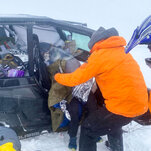
87 Rescued From ‘Near-Whiteout’ Conditions During Utah Ultramarathon

The runners were participating in a 50-mile race when they were caught in 12 to 18 inches of snow in the Wasatch Mountain range north of Salt Lake City.

Kelcey McClung Stowell said she had been told to prepare for some rain and perhaps a “tiny dusting of snow” in the higher elevations before the start on Saturday of the DC Peaks 50, a 50-mile ultramarathon through the rugged mountains of Utah.
But several hours into the race, Ms. Stowell said, the snow started coming down “really, really heavily,” and the wind started howling at 30 or 40 miles an hour.
“As it got colder and colder, it was getting scary,” she said. “The snow was getting so deep, we couldn’t see the trail. It was coming down like hail, and my hood froze to my face.”
She began really worrying, she said, “because it was brutally cold,” and she was wearing only pants, a shirt and a jacket. Other runners were in shorts, she said.
“I started shivering, but there was nothing we could do but get to the next aid station,” she said. “So we just kept moving.”
Ms. Stowell, of Ogden, Utah, was among 87 ultramarathoners who were rescued on Saturday in the Wasatch Mountain range north of Salt Lake City after they were caught in 12 to 18 inches of snow and “near whiteout conditions,” the Davis County Sheriff’s Office said.
Race organizers called off the race, and search-and-rescue workers covered the entire course on foot as well as with four-wheel-drive vehicles and snowmobiles for several hours to help all the runners get off the mountains safely, the Sheriff’s Office said.
A few racers were treated at the base of the mountains for hypothermia, the authorities said. One of the runners also sustained a minor injury from a fall. All were released at the scene.
The Sherif’s Office said the first call for help came at 9:30 a.m. local time, and all of the runners were accounted for by 2:45 p.m. The last rescuers left the mountain range at about 7 p.m. because they had to navigate “treacherous conditions” on their way down, the office said.
“Venturing onto the mountains, trails, and bodies of water at this time of year can be dangerous because the weather changes rapidly,” Kelly V. Sparks, the Davis County sheriff, said in a statement. “Even a mild rain in the valley can translate to blizzard conditions at higher elevations.”
The DC Peaks 50, which was being held for the first time, was to take runners along a mountainous course that is mostly trails but also includes some service roads and 2.5 miles of paved road, according to the race’s website. It is described on the website as “a tough course” with a roughly 11,700-foot vertical gain and an 8,637-foot descent.
Jake Kilgore, a race director, said he and the other director, Mick Garrison, spent two years planning the race, working with the United States Forest Service and others on the route. There were 87 runners in the race and six aid stations along the way, each one headed by an experienced ultramarathoner, Mr. Kilgore said.
The runners were about 8 miles into the race when the conditions deteriorated, he said.
“It was raining at the starting line, and it had forecasted rain,” Mr. Kilgore said. “Nobody had forecasted over a foot of snow at Francis Peak. Nobody.”
He said ultramarathoners are aware of the risks involved in the sport, like big-wave surfers or kite surfers. After the race was canceled, he said, runners had emailed him to say they were safe and “they all are excited to come back next year.”
“The fact that we have every single runner accounted for means that this race was a very successful race today,” Mr. Kilgore said.
Once considered a niche extreme sport, ultrarunning has soared in popularity in the last two decades. Critics have argued that some of the races have begun to blur the lines between the rugged and the reckless, and in the process, shifted the definition of an endurance race from conquering long distances to surviving the elements.
In May, 21 runners died in China after freezing rain and high winds struck a 62-mile mountain race. Hours into the event, the weather suddenly deteriorated, and runners dressed in shorts and T-shirts were suddenly facing freezing conditions and hail. Some passed out from the cold. About 1,200 people joined the rescue effort.
Ms. Stowell said she had hypothermia and was grateful when she reached a truck that had the heater blasting. When she got to the base of the mountains, workers were handing out hot broth and hot chocolate, she said.
She said she did not blame race organizers for allowing runners to head into such extreme conditions.
“On the contrary, I think they were absolutely amazing,” she said, and helped get people to safety.
Alex Michael of Clearfield, Utah, who was running the race with his daughter, who is 17, said that he was more miserable than scared after they were pelted by the heavy, cold, sleet-like snow.
“We were only supposed to have an inch or two of snow,” he said. “I just don’t think anyone was quite prepared for what it was at the top. That’s the joy of Utah mountains.”
Source: https://www.nytimes.com/2021/10/09/us/utah-ultramarathon-snow-rescue.html















